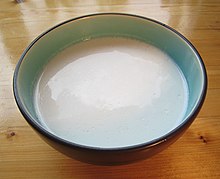**History and Types of Plant Milk:**
– Plant-based mixtures resembling milk have existed for centuries in various cultures.
– Native American tribal nations in the northeastern United States made milk and infant formula from nuts.
– The term ‘milk’ has been used to refer to milk-like plant juices since 1200 CE.
– Soy milk was used in China during the 14th century.
– Common plant milks include almond, coconut, rice, soy, hemp, oat, pea, and peanut milk.
– Plant milks can be made from grains, pseudocereals, legumes, nuts, seeds, and other sources.
– Traditional plant milk recipes include Kunu from Nigeria, Sikhye from Korea, and Amazake from Japan.
**Manufacturing and Nutritional Comparison:**
– Greenhouse gas emissions, water use, and land use vary among different plant milks.
– Manufacturing involves steps like cleaning, grinding, heating, and homogenizing.
– Ingredients like guar gum, xanthan gum, and micronutrients are commonly added during manufacturing.
– Plant milks are lower in nutrient density than dairy milk and are often fortified.
– Both plant and animal milks are commonly fortified with nutrients like calcium and vitamins A and D.
– Nutritional values like fat, carbohydrates, fiber, sugars, vitamins A and D, and cholesterol vary between plant and cow’s milk.
**Market Trends and Industry Developments:**
– Plant milk industry in the US was worth $1.8 billion per year in 2019.
– Dairy alternatives globally were valued at $8 billion in 2018.
– Oat milk sales increased by 250% in Canada in 2019.
– Oat milk sales in the US reached $213 million in 2020.
– Plant milk sales in the US grew steadily by 61% from 2012 to 2018.
– Major coffee retailer Starbucks added oat, coconut, and almond milk beverages in 2020.
**Health Concerns, Recommendations, and Labeling Controversy:**
– Plant milks are not recommended for infants under 12 months, and commercial infant formula is advised for infants.
– Plant milks are not equivalent substitutes for human milk in infants.
– European Union regulations restrict terms like milk, butter, cheese to animal products.
– FDA in the US has not enacted regulations against plant-based milk labels.
– Health authorities emphasize the importance of appropriate infant formulas.
– Proposal to restrict labels like yogurt-style and cheese alternative failed in the EU.
**Environmental Impact and Ethical Concerns:**
– Negative perception of dairy due to environmental impacts and animal welfare concerns contribute to the decline in dairy milk popularity.
– Plant milk advertising contrasts intensive dairy farming with plant sources.
– Documentaries like Cowspiracy raise awareness about dairy’s environmental impact.
– Increased concern about dairy production’s effects on biodiversity and resources.
– Sustainable eating practices and the impact of different vegan milks on the planet are important considerations.
Plant milk is a plant beverage with a color resembling that of milk. Plant milks are non-dairy beverages made from a water-based plant extract for flavoring and aroma. Plant milks are consumed as alternatives to dairy milk, and may provide a creamy mouthfeel.
 | |
| Type | Non-dairy beverage and ingredient |
|---|---|
| Color | White |
| Flavor | Various; creamy texture |
| Ingredients | Water and a grain, pseudocereal, legume, nut, seed, or coconut |

As of 2021, there are about 17 different types of plant milks; almond, oat, soy, coconut, and pea are the highest-selling worldwide. Production of plant-based milks, particularly soy, oat, and pea milks, can offer environmental advantages over animal milks in terms of greenhouse gas emissions, land and water use.
Plant-based beverages have been consumed for centuries, with the term "milk-like plant juices" used since the 13th century.[citation needed] In the 21st century, they are commonly referred to as plant-based milk, alternative milk, non-dairy milk or vegan milk. For commerce, plant-based beverages are typically packaged in containers similar and competitive to those used for dairy milk, but cannot be labeled as "milk" within the European Union.
Across various cultures, plant milk has been both a beverage and a flavor ingredient in sweet and savory dishes, such as the use of coconut milk in curries. It is compatible with vegetarian and vegan lifestyles. Plant milks are also used to make ice cream alternatives, plant cream, vegan cheese, and yogurt-analogues, such as soy yogurt. The global plant milk market was estimated to reach US$62 billion by 2030.
